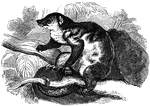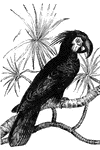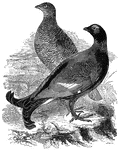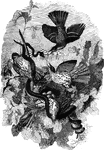
Pithecheirus Melanurus
"This includes one animal, the P. melanurus, which has puzzled the naturalists, inasmuch as…

Execution Preparations
"Preparing the prisoner for execution- putting on the black robe."— Frank Leslie, 1896
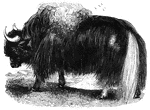
Yak
"The color of this animal in the wild and take, is black; the back and tail often white; the hair is…
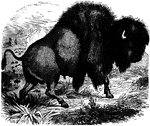
American Bison
"The head is very large and carried low; the eyes are small, black, and piercing; the horns are short,…
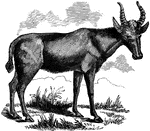
Bubula
"Is of a reddish-fawn color, with black horns, shaped like the tines of a fork. "— S. G. Goodrich,…

Bloody Pavao
The bloody pavao (coracina scutata) is a mostly black bird, which gets its name from the blood…

Blackbird
Black with a yellow bill, the blackbird feeds mostly on larvae, snails, worms, insects, and fruits.
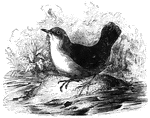
Black Dipper
The black dipper, also known as the European water-ousel, feeds on small shellfish and insects.
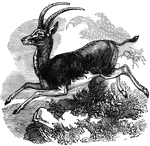
Blauw-Boc
"Is six feet long, three feet seven inches high, has round horns curved backward, and is of a blu-ish…

Black-Lored Tit
Native to the Himalaya Mountains, P. xanthogenys is somewhat smaller than the great tit.

Black Redstart
A black redstart perched on a branch in front of a stone building. It greatly resembles the redstart.
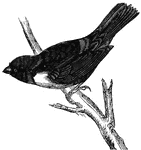
Scarlet Tanager
The scarlet tanager (also known as the black-winged summer redbird, or fire bird) feeds on insects,…
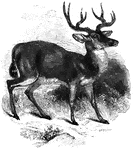
Mule Deer
"Is between the common deer and the American elk in size. Its horns are round and twice forked; the…

Black-billed cuckoo
Averaging about twelve and a half inches in length, the black-billed cuckoo resembles the yellow-billed…
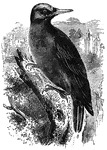
Great black Woodpecker
Chiefly making its habitat in Northern Europe, the great black woodpecker uses its long, sharp bill…
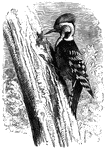
Middle Spotted Woodpecker
Found in Southern Europe, the middle spotted woodpecker has a black coat, with a crimson underside and…
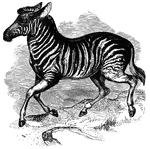
Dauw
"Is of a pale brown color; the underside of the body being whitish; head, body, and upper part of the…
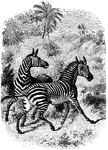
Zebras
"The ground color is white, or yellowish white, but the head, body, and legs to the hoofs are regularly…

Guinea Hog
"It is of the size of a common hog; has long, narrow, straight ears, with a pencil of hair at the tips.…

Beluga Whale
"When young it is black, when mature white, sometimes having a yellowish or rosy tinge. It is twelve…

Porpoise
"This is from four to eight feet long, and nearly of a black color above, beneath whitish." —…

Manatee
"It is of a gray-black color, nine or ten feet long, and has vestiges of nails on the edges of the flippers,…
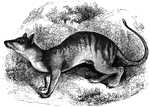
Tasmanian Wolf
"It is the size of a small wolf, with short, smooth, hair of dusky yellowish-brown color, barred on…

Banded Ant Eater
"It is about ten inches long, of a tawny color, marked with transverse bands of black and white. The…

Black Friday
"The New York Gold Room on 'Black Friday,' September 24, 1869."—E. Benjamin Andrews 1895
!["The broad-billed sandpiper.. [is] six and a half inches long, variegated above with black, rufous, and gray; beneath grayish-white, tinged with buffish-red; rare, but distributed throughout Europe." — Goodrich, 1859](https://etc.usf.edu/clipart/13000/13073/bblldsndpipr_13073_mth.gif)
Broad-Billed Sandpiper
"The broad-billed sandpiper.. [is] six and a half inches long, variegated above with black, rufous,…
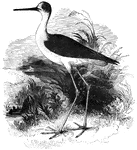
Black-Winged Stilt
Also known as the European stilt, the black-winged stilt inhabits coastal areas where it forages for…
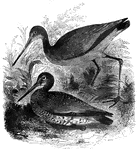
Black-Tailed Godwits
The black-tailed godwit measures about sixteen inches in length, and is found throughout Europe during…
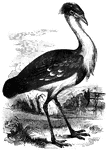
Black-Billed Bustard
Found in India, the black-billed bustard can measure up to four and a half feet in length.
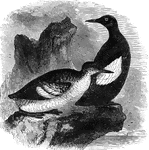
Black Guillemot
Found in the arctic regions of Europe and America, the black guillemot averages about thirteen inches…
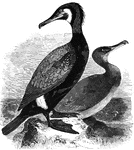
Black cormorant
The black cormorant averages about three feet in length, and is found in Greenland, as well as a long…
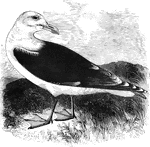
Great Black-Billed Gull
Feeding chiefly on fish, the great black-billed gull has been known to feed on small birds.

Ilex
Leaves usually with a few remote teeth above the middle or at least bristle-tipped; fruit a red or black…
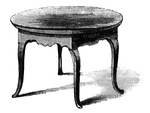
Treaty Table
The Treaty Table. The table on which the capitulation was drawn up and signed was still in possession…
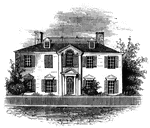
Arnold's residence
Arnold's residence. Arnold lived in Water Street, near the ship-yard. The house is still standing (1848),…
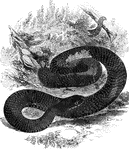
Black viper
Found in Europe from Sweden to the Medittanean Sea, the black viper is also the only venemous reptile…

Golden Tree Snake
"Four to five feet long; color yellowishgray, cleaning with a pale golden hue, and dotted with whitish…

Violet-colored salamander
"Is five to seven inches long,; blueish-black, with bright yellow spots; habits nocturnal, living under…

Siren lacretina
"Two feet long, black above and dusky beneath. It is of an eel-like form, lives in the muddy water of…

Axolotl
"Ten to fiteen inches long, of a brownish or grayish color, spotted with black. On each side of the…

European Blackfish
"Two to three feet long, remarkable for its swiftness and voracity; the color is black, the body covered…

Black Goby
"It is five to six inches long, and found on the rocky coasts of Europe. It is not esteemed for food."…

Lumpfish
"It is of thick, massive form, and often weighs as much as six or seven pounds; it is of a purplish-black…
Coalfish
"A large species, weighing from ten to thirty pounds. It swims rapidly, and at no great depth." —…

Salmon
"The salmon two to four feet long, and weighs ten to twelve pounds, though it has been taken of eights…
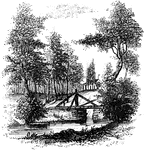
Sleepy Hollow
"Bridge over Sleepy Hollow Creek. Ichabod, according to Irving, in the Legend, returning from…

Tench
"Found in most Europes lakes in rivers. It is exceedingly tenacious of life; loves foul and weedy water;…
!["Siege of Petersburg- the Ninth Corps charging on the enemy's works after the explosion of the mine, July 30th, 1864. Immediately after the explosion of the mine a hundred cannons opened along the Federal front, and at half-past five the Ninth Corps charged, carrying the fort with a part of the line on each side. The Second Division, which was in the centre, advanced and carried the second line a short distance beyond the fort, and rested, holding ground with the utmost determination. It was at the time the [African American] Division, under General White, was pushed forward and ordered to charge and carry the crest of the hill, which would have decided the contest. The troops advanced in good order as far as the first line, where they received a galling fire, which checked them, and although quite a number kept on advancing, the greater number seemed to become utterly demoralized, part taking refuge in the fort, and the remainder running to the rear as fast as possible. They were rallied and again pushed forward, but without success, the greater part of the officers being killed or wounded."— Frank Leslie, 1896](https://etc.usf.edu/clipart/13900/13915/petersburg_1_13915_mth.gif)
Siege of Petersburg
"Siege of Petersburg- the Ninth Corps charging on the enemy's works after the explosion of the mine,…
!["Siege of Petersburg- the Ninth Corps charging on the enemy's works after the explosion of the mine, July 30th, 1864. Immediately after the explosion of the mine a hundred cannons opened along the Federal front, and at half-past five the Ninth Corps charged, carrying the fort with a part of the line on each side. The Second Division, which was in the centre, advanced and carried the second line a short distance beyond the fort, and rested, holding ground with the utmost determination. It was at the time the [African American] Division, under General White, was pushed forward and ordered to charge and carry the crest of the hill, which would have decided the contest. The troops advanced in good order as far as the first line, where they received a galling fire, which checked them, and although quite a number kept on advancing, the greater number seemed to become utterly demoralized, part taking refuge in the fort, and the remainder running to the rear as fast as possible. They were rallied and again pushed forward, but without success, the greater part of the officers being killed or wounded."— Frank Leslie, 1896](https://etc.usf.edu/clipart/13900/13917/petersburg_2_13917_mth.gif)
Siege of Petersburg
"Siege of Petersburg- the Ninth Corps charging on the enemy's works after the explosion of the mine,…
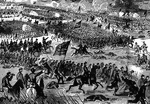
Battle of Champion Hills
"Battle of Champion Hills, May 16th, 1863- the formidable position of General Pemberton carried by Generals…

Battle of Champion Hills
"Battle of Champion Hills, May 16th, 1863- the formidable position of General Pemberton carried by Generals…
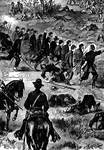
Battle of Champion Hills
"Battle of Champion Hills, May 16th, 1863- the formidable position of General Pemberton carried by Generals…

Marine trumpet-shell
"The marine trumpet or Triton's shell, Triton variegatus, is elegantly variegated with red…
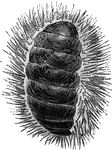
Chiton spinosus
"The Chiton spinosus is bordered by long, black, aculeted spines; found in the South Seas;…
